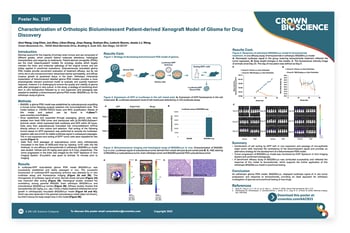- Our Services
- Platforms
- Target Solutions
- Technologies
- Service Types
- Our Science
- About Us
- Contact us
Jinxi Wang, Ling Chen, Jun Zhou, Likun Zhang, Jinyu Huang, Xueluan Zhu, Ludovic Bourre, Jessie J.J. Wang
Crown Bioscience Inc., 16550 West Bernardo Drive, Building 5, Suite 525, San Diego, CA 92127

Gliomas account for the majority of primary brain tumors and are composed of different grades, which present distinct molecular alterations, histological characteristics and response to treatments. Subcutaneously inoculated glioma patient-derived xenograft (PDX) models provide convenient evaluation of treatment efficacy, but do not mimic the in situ microenvironment, blood-brain barrier permeability, and diffuse invasive growth to peripheral tissue in the brain. Orthotopic intracranial implantation of bioluminescent labelled glioma PDX models provides a more physiologically relevant preclinical model to evaluate and quantify treatment response, however it is challenging to ensure the quality and viability of glioma cells after prolonged in vitro culture. In this study, a strategy of combining short term in vitro transduction followed by in vivo expansion and passaging was adopted to establish a bioluminescent glioma PDX model, BN2289-Luc, for the orthotropic study of glioma.
Your privacy is important to us.
We'll never share your information.
© 2025 Crown Bioscience. All Rights Reserved.
Privacy Policy | Imprint | Terms of Service | Privacy Preferences


© 2025 Crown Bioscience. All Rights Reserved. Privacy Policy
2023-04-25
2023-04-07
landing_page
AACR 2023